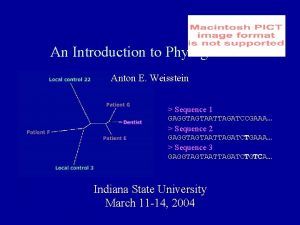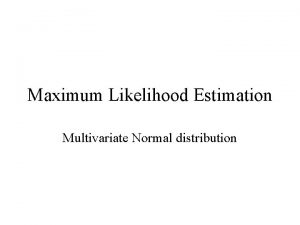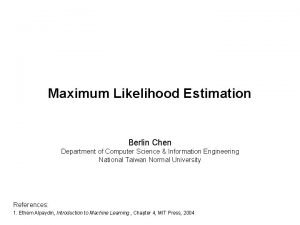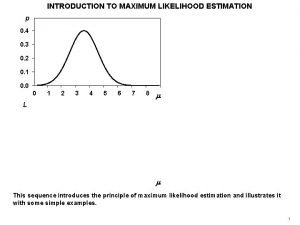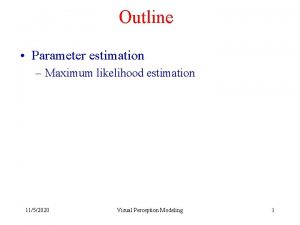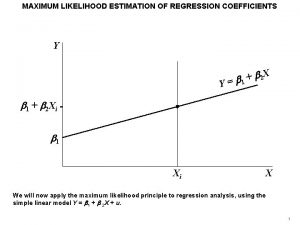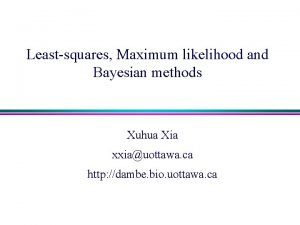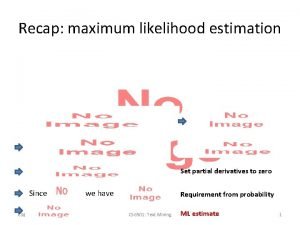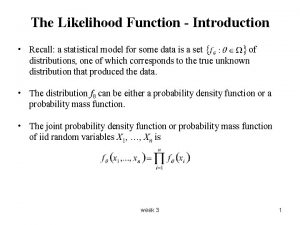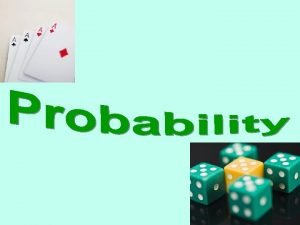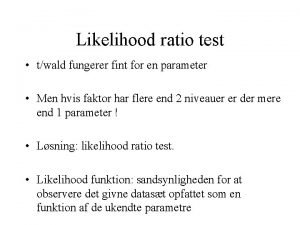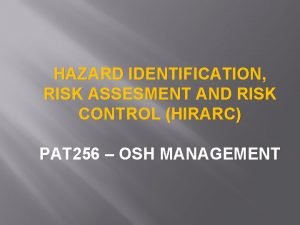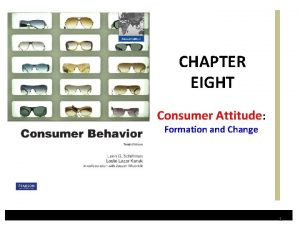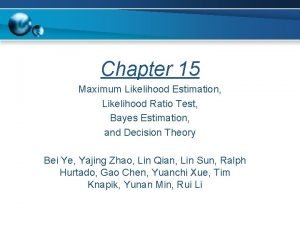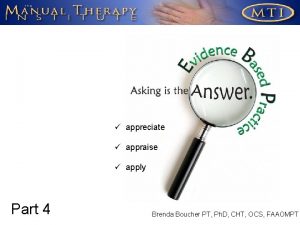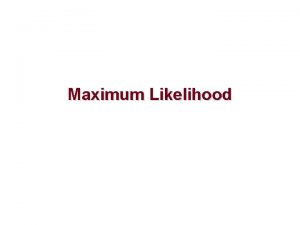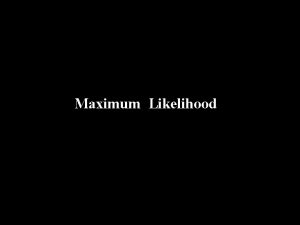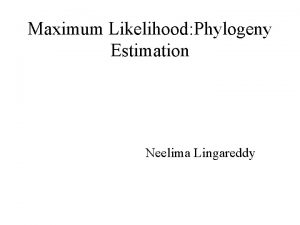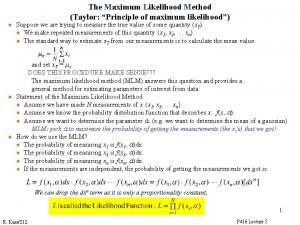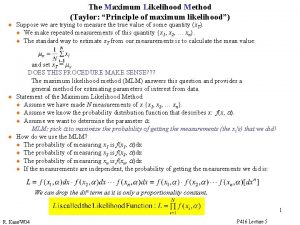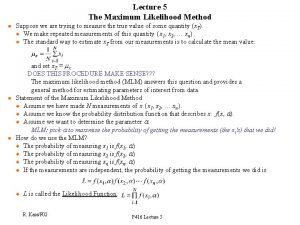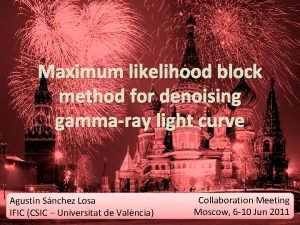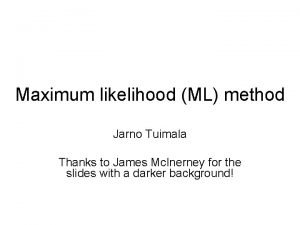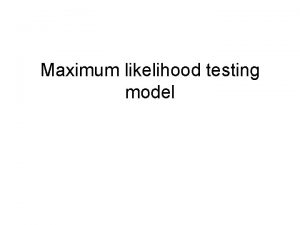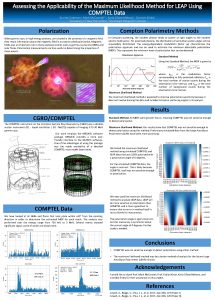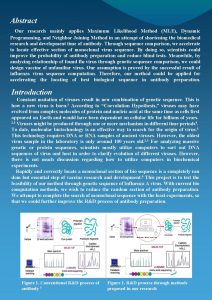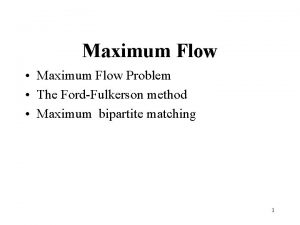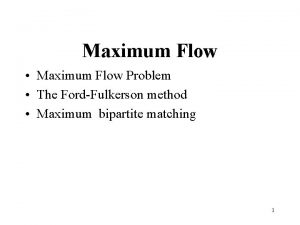The Method of Maximum Likelihood What is the





















- Slides: 21

The Method of Maximum Likelihood What is the appropriate condition to be satisfied for the sample population to best represent the parent population? Physics 310

Section 4. 1 Physics 310 In chapter 2, we defined the mean of a sample population as: . How do we show that this is statistically the most probable agreement with which represents the parent population . .

The parent population The probability of making a measurement when the mean of the parent population is and the standard deviation is is just -. . This assumes the distribution of random fluctuations about the mean is Gaussian. Physics 310

Estimating the mean. . . We do not know or apriori so we must estimate them from our data as ’ and ’. We will assume that the width of the sample distribution will very closely approximate the width parent population so ’ We will try to find a method for estimating ’ so that it is most probable that this estimate will represent the value of corresponding to the parent population. Physics 310

Finding the most probable value If ’ represents the mean of the sample population, then the probability of measuring a value from this sample is. . . The probabilty of getting all of the values in our sample is just the product - Physics 310

Total probability for sample. . This expands to the following on substitution. . . Now, suppose that we tried all different values of getting different values of Physics 310

Maximum probability To maximize the probability we must minimize the exponent, call it X . Maximizing the probability is equivalent to saying this will be most likely represent the parent population. Physics 310 . .

Minimize X to maximize P( ’) Physics 310

Estimate the error on ’ Physics 310 How much does each xi contribute to the uncertainty in ’ ?

What if all i are not equal? This implies that the uncertainty on the individual datum points is different. We should respect this by weighting those with smaller uncertainties more than those measurements with larger uncertainties when we calculate the mean ’ Physics 310

Maximum probability Again, to maximize the probability we must minimize the exponent, call it X. . . And as before, maximizing the probability is equivalent to saying this will be most likely represent the parent population. Physics 310

Minimize X to maximize P( ’) Physics 310

Estimate the error on ’ Physics 310 How much does each xi contribute to the uncertainty in ’ ?

How do we test the agreement? Suppose we have a frequency distribution representing our measurements. We postulate that these data come from a specific parent population distribution. How do we test whether this postulate is supported statistically? Physics 310

The test -2 Physics 310 We define a comparison between the data (in this case a frequency distribution or histogram) and the function (which characterized the parent population) called the 2 as follows --

The test -2 Where the 2 included - h is the measured frequency (number of observations) in histogram bin identified with xj ( j implying the bin number) NP(xj ) is the predicted number of observations in bin at xj if P(xj ) is the hypothesized probability distribution. j is the uncertainty on the number in bin h. Physics 310

In , j(h) estimated as -2, Physics 310

What do we expect for ? 2? Physics 310 Imagine that, on average, the deviations (numerator) were ~ 1 . Then, the total 2 for n bins would be ~ n! Statistically, we expect for 2 the value

What do we expect for ? 2? Here, is the statistically expected value for 2. is the number of degrees of freedom n is the number of data points (bins) nc is the number of constraints on the data Physics 310

Calculations. . . Calculate 2 for each datum point Sum the individual 2 to get the total 2 Determine the number of constraints nc Physics 310 Calculate the reduced 2 and compare to 1

Conclusions. . . What do you conclude if is ~1? What do you conclude if is >>1? What do you conclude if is <<1? What do you do if one point has a very large value of 2 ? Physics 310
 Maximum parsimony vs maximum likelihood
Maximum parsimony vs maximum likelihood Maximum likelihood vs maximum parsimony
Maximum likelihood vs maximum parsimony Likelihood function
Likelihood function Mle of variance
Mle of variance Maximum liklihood
Maximum liklihood Maximum likelihood estimation
Maximum likelihood estimation Fiml in mplus
Fiml in mplus Nrmd
Nrmd Maximum likelihood
Maximum likelihood Maximum likelihood
Maximum likelihood Ppdf
Ppdf Lsa uva
Lsa uva Absolute max vs local max
Absolute max vs local max Likelihood function
Likelihood function The likelihood that an event will occur.
The likelihood that an event will occur. Twald
Twald Likelihood ratio
Likelihood ratio Example of hirarc report
Example of hirarc report Changing the basic motivational function
Changing the basic motivational function Likelihood ratio
Likelihood ratio Elaboration likelihood model
Elaboration likelihood model Negative likelihood ratio
Negative likelihood ratio

